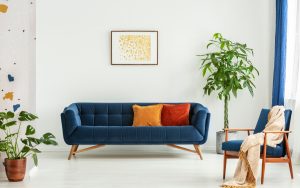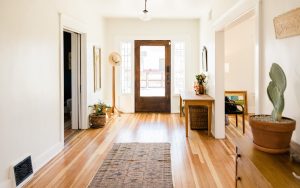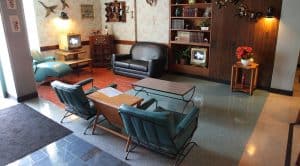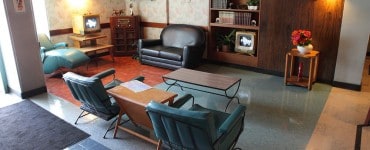Step into a world where elegance meets innovation, where nostalgia intertwines with contemporary flair – welcome to the captivating realm of Mid-Century Modern interiors. As design enthusiasts and homeowners alike continue to embrace this iconic style, the quest for understanding its magic intensifies. Among the many elements that make Mid-Century Modern interiors truly special, textures stand out as a pivotal and often overlooked aspect.
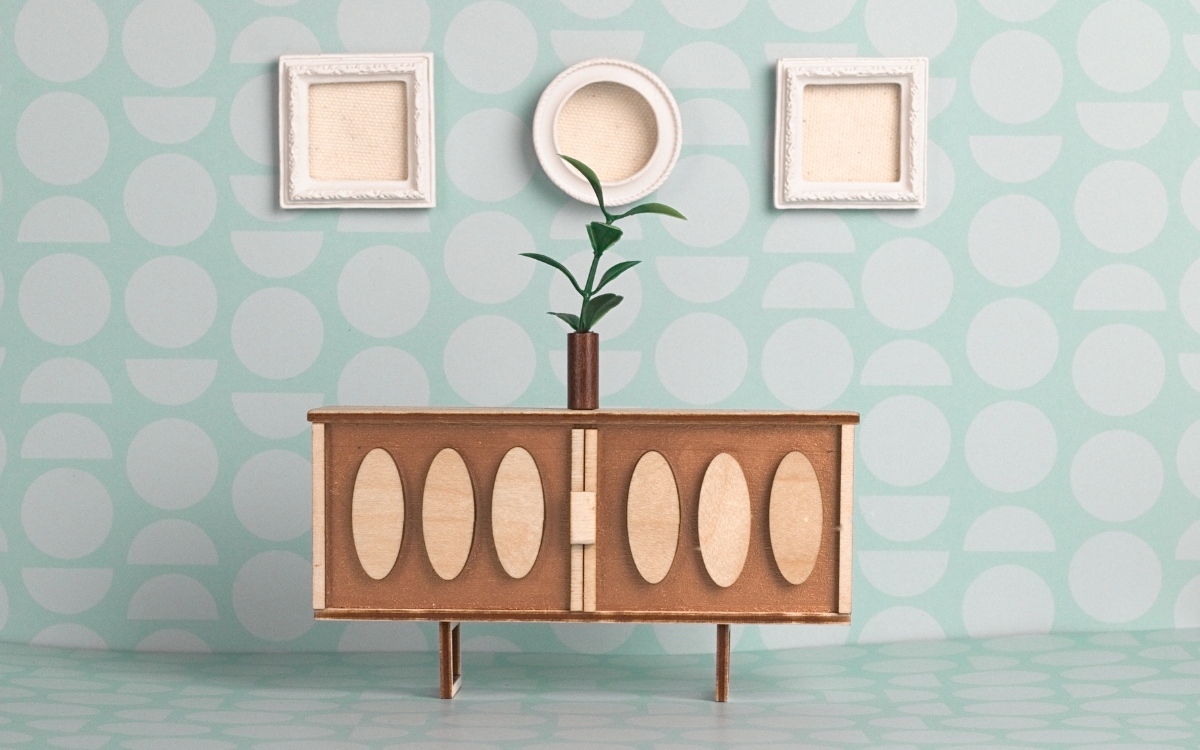
In this comprehensive blog post, we embark on a journey to unravel the crucial role textures play in the captivating world of Mid-Century Modern design. Delving into the very essence of this remarkable aesthetic, we will explore how textures have the power to evoke emotions, create sensory experiences, and elevate spaces to new heights of sophistication.
The Impact of Textures in Interior Design
Interior design is an artful fusion of elements that come together to create spaces that evoke emotions and captivate the senses. While color, form, and layout play significant roles in shaping the ambiance, textures emerge as a crucial aspect that adds depth, character, and a distinct touch to any interior setting.
From the smooth surfaces of polished wood to the inviting softness of plush fabrics, textures create a multisensory experience that goes beyond visual appeal. In this exploration of the impact of textures in interior design, we unveil the transformative power they hold in elevating spaces and how they contribute to the overall aesthetics and emotional connection within a room.
Enhancing Visual and Tactile Appeal
One of the primary roles of textures in interior design is to enhance both the visual and tactile appeal of a space. Textures offer a diverse range of surfaces that can be smooth, rough, velvety, or coarse, inviting individuals to engage their sense of touch.
A room adorned with various textures not only pleases the eye with its aesthetic variety but also invites touch, encouraging visitors to interact with the space on a deeper level. The juxtaposition of textures, such as combining a plush rug with a sleek glass tabletop, creates an intriguing contrast that adds sophistication and complexity to the overall design.
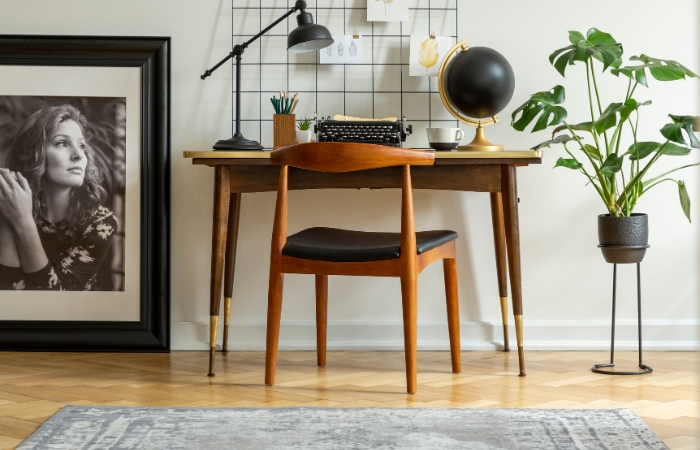
Creating Emotional Connections
Textures have an uncanny ability to evoke emotions and create unique atmospheres within interiors. For instance, the warmth of natural wood textures can instill a sense of comfort and coziness, making a living room a welcoming retreat.
Conversely, smooth and polished surfaces in a contemporary kitchen might exude a feeling of modernity and efficiency. By thoughtfully selecting textures that align with the desired emotional tone of a room, interior designers can elicit specific feelings, be it tranquility, energy, or nostalgia, from those who inhabit the space.
Adding Dimension and Depth
Incorporating textures into interior design adds a layer of dimension and depth to a room, making it more visually interesting and captivating. Textured surfaces create shadows and highlights, playing with light in ways that flat, uniform surfaces cannot achieve.
The interplay of light and shadows not only adds visual intrigue but also brings a sense of movement to the space. Designers can strategically use textures to draw attention to certain focal points or architectural features, further enhancing the overall design scheme.
Establishing a Sense of Identity
Each space should have its own unique identity, reflecting the personality and preferences of its inhabitants. Textures play a pivotal role in establishing this sense of identity by providing a canvas through which personal tastes can be expressed. Whether it’s through the rustic charm of exposed brick walls, the opulence of velvet drapes, or the eclectic mix of textured decor items, the carefully curated textures in a room showcase the homeowner’s individuality and style.
Balancing Design Elements
In interior design, achieving balance is essential to create harmonious spaces. Textures act as a balancing tool, helping to distribute visual weight and maintain equilibrium within a room. The right mix of textures prevents a space from feeling monotonous or overwhelming. When combined with other design elements such as colors and patterns, textures become integral in striking the perfect balance, resulting in a well-designed and visually pleasing interior.
Textured Tales from Mid-Century Modern History
The mid-20th century marked a groundbreaking era in design, where innovation, creativity, and a departure from traditional aesthetics birthed the iconic movement of Mid-Century Modern design. Amidst the clean lines and sleek forms that defined this style, textures played a significant role in shaping the visual allure of interiors.
As we delve into the textured tales from Mid-Century Modern history, we uncover the evolution of textures in this design movement, the pioneering designers who harnessed their power, and the classic textured pieces that continue to inspire contemporary interpretations.
The Evolution of Textures in Mid-Century Modern Design
Mid-Century Modern design emerged as a response to the post-war era, with a focus on functionality, simplicity, and an optimism for the future. In its early stages, textures in interior design were relatively subdued, as the movement emphasized a minimalist approach.
Natural materials like wood and stone were prevalent, showcasing their raw and unadorned textures. As the movement evolved, designers began experimenting with more diverse textures, introducing materials like fiberglass, acrylic, and chrome to create captivating contrasts in interior spaces. The fusion of different textures became a defining feature of Mid-Century Modern design, allowing for spaces that felt both visually stimulating and harmonious.
Pioneering Designers: How Textures Shaped Mid-Century Interiors’ Icons
The architects and designers of the Mid-Century Modern movement played a pivotal role in elevating textures to the forefront of interior design. Visionaries like Charles and Ray Eames, known for their iconic Eames Lounge Chair, masterfully combined various textures in their furniture designs.
The juxtaposition of smooth leather against warm wood and polished metal showcased their ingenious use of materials to create pieces that were not only aesthetically pleasing but also incredibly comfortable. Similarly, the innovative Isamu Noguchi experimented with organic textures in his furniture and lighting designs, infusing spaces with a sense of nature’s touch.
Classic Textured Pieces: Timeless Examples of Mid-Century Modern Textured Excellence
Several iconic textured pieces from the Mid-Century Modern era continue to inspire designers and enthusiasts today. The Womb Chair, designed by Eero Saarinen, exemplifies the use of soft, textured upholstery that embraces users in a cozy embrace.
The Bubble Lamp, a creation of George Nelson, captivates with its ethereal, textured cocoon-like shape that diffuses light beautifully. Additionally, the Knoll Barcelona Chair, designed by Ludwig Mies van der Rohe, showcases the sleek juxtaposition of textured leather against the smooth steel frame, epitomizing the movement’s signature marriage of contrasting materials.
Contemporary Revival: Textures in Mid-Century Modern-Inspired Spaces
As the fascination with Mid-Century Modern design continues to thrive, so does the exploration of textures in contemporary interpretations. Interior designers and homeowners today embrace the timeless appeal of textures from this era while infusing a fresh, modern twist.
The resurgence of shaggy rugs, tufted upholstery, and textured wall treatments pays homage to the movement’s love for tactile elements. Additionally, the introduction of sustainable and eco-friendly textured materials aligns with the movement’s original focus on functionality and innovation.
Exploring Texture Variety in Mid-Century Modern Interiors
Mid-Century Modern interiors are celebrated for their clean lines, sleek forms, and a harmonious blend of functionality and aesthetics. Beyond the iconic silhouettes, textures play a pivotal role in elevating these spaces to new heights of visual intrigue and tactile delight.
From the warm embrace of natural materials to the sumptuous softness of fabrics, the texture variety in Mid-Century Modern interiors offers a rich tapestry of sensations. In this exploration, we uncover the diverse textures that define this design era and how they contribute to the overall ambiance and character of these timeless spaces.
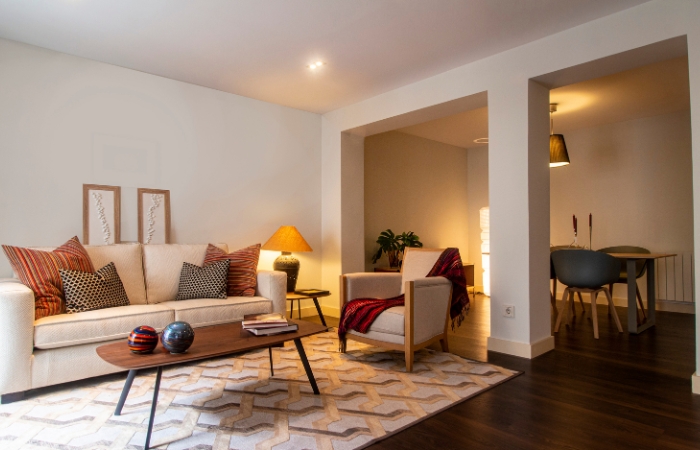
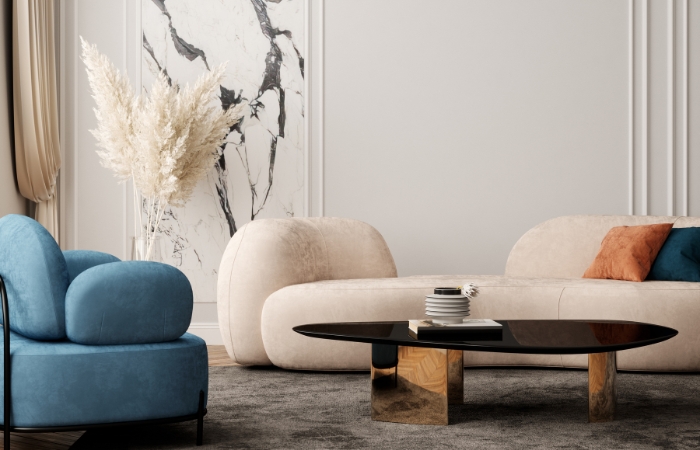
Natural Materials and Finishes: Celebrating Wood, Stone, and Organic Surfaces
At the heart of Mid-Century Modern design lies a deep appreciation for nature’s beauty, which is mirrored in the prominent use of natural materials and finishes. Wood, in particular, takes center stage, with rich walnut, teak, and rosewood being favored choices for furniture and cabinetry.
These woods boast warm textures, showcasing their natural grains and knots, which not only add visual interest but also create a sense of comfort and familiarity. Stone surfaces, such as marble and slate, make occasional appearances, providing a cool and elegant contrast to the warmth of wood textures. These organic surfaces connect the interior spaces to the outdoors, blurring the boundaries between nature and design.
Plush and Luxurious: Embracing Soft Textiles in Mid-Century Modern Spaces
While the movement celebrates clean lines and hard surfaces, it also indulges in the luxurious comfort of soft textiles. Plush upholstered sofas and armchairs, often in rich velvets or soft leathers, invite relaxation and leisure.
Textured area rugs, featuring shaggy or tufted designs, infuse the floor with coziness and depth. In bedrooms, bedding and throw pillows made from soft fabrics like wool or mohair provide tactile indulgence, transforming sleeping spaces into havens of comfort. The juxtaposition of soft textiles against the sleek forms of Mid-Century Modern furniture creates a balanced and inviting interior.
Mixing and Matching: Creating Texture Harmony with Diverse Elements
A defining characteristic of Mid-Century Modern design is its skillful mixing and matching of various elements, including textures. Designers embrace the art of harmonizing diverse textures to achieve a cohesive and visually appealing space.
For instance, a smooth and glossy fiberglass coffee table might be paired with a velvety upholstered sofa, while a polished chrome floor lamp stands beside a rough-textured brick accent wall. This thoughtful layering of textures ensures that the eye is continually engaged and delighted as it moves throughout the room, uncovering new tactile experiences at every turn.
Balancing Textured and Sleek Surfaces: Finding Visual Equilibrium
The interplay between textured and sleek surfaces is a delicate balance that defines Mid-Century Modern interiors. The movement is characterized by a preference for uncluttered spaces, where every design element serves a purpose. As such, textures are thoughtfully incorporated to add depth and character without overwhelming the clean lines.
A textured accent wall or a textured area rug can anchor a room, providing a focal point that complements the smooth surfaces of iconic furniture pieces. By maintaining this visual equilibrium, Mid-Century Modern interiors achieve a harmonious and sophisticated aesthetic.
The Emotional Language of Textures
In the world of interior design, textures are not just about visual aesthetics; they also communicate a rich and evocative emotional language. From the inviting comfort of a plush fabric to the rugged charm of weathered wood, textures have the extraordinary power to elicit emotions and create distinct atmospheres within a space.
In this exploration of the emotional language of textures, we delve into how different textures can evoke feelings of warmth, tranquility, energy, and nostalgia, adding depth and personality to interiors that resonate with the inhabitants and visitors alike.
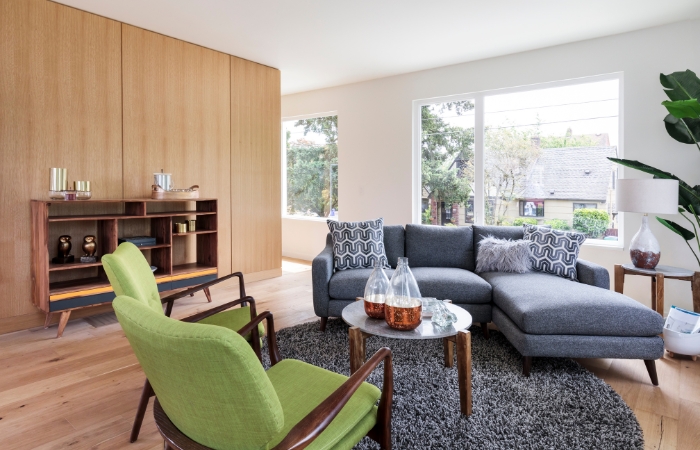
Warm and Cozy: How Textured Mid-Century Modern Spaces Foster a Sense of Home
Certain textures have an inherent ability to envelop spaces in an aura of warmth and coziness. Soft and inviting fabrics like velvet or chenille on sofas and armchairs create an immediate sense of comfort and relaxation, inviting occupants to unwind and feel at home.
Mid-Century Modern spaces that embrace these textures exude a welcoming and nurturing ambiance, making them ideal retreats from the outside world. Additionally, the use of natural materials like warm-toned wood or exposed brick walls contributes to this inviting atmosphere, infusing spaces with a rustic charm that feels familiar and lived-in.
Inviting Serenity: Using Textures to Create Tranquil and Relaxing Environments
Textures can also play a significant role in crafting serene and calming environments within Mid-Century Modern interiors. Smooth and cool textures, such as polished stone or glass surfaces, invoke a sense of tranquility and balance. These sleek textures create a feeling of order and simplicity, fostering a Zen-like atmosphere that promotes relaxation and mindfulness. I
n bedrooms, soft linens and cotton bedding contribute to a soothing ambiance, creating a haven for rest and rejuvenation. By thoughtfully selecting textures that evoke serenity, interior designers can curate spaces that offer respite from the fast-paced world outside.
Playful and Energetic: Infusing Spaces with Dynamic Textures and Vibrancy
Textured elements can also inject a sense of playfulness and energy into Mid-Century Modern interiors. Bold patterns and textures, such as geometric wallpapers or textured tiles, create visual interest and capture attention. Vividly colored textiles and decor items add vibrancy to spaces, infusing them with a lively and youthful spirit.
These dynamic textures inject a sense of joy and excitement, making the interiors feel alive and spirited. Incorporating playful textures into Mid-Century Modern design allows for creative expression and celebrates the exuberance of the era.
The Nostalgic Touch: Texture’s Role in Eliciting Sentiment and Memory
Textures hold a unique power to evoke nostalgia and sentiment within interior spaces. Mid-Century Modern design itself often draws inspiration from the past, and the use of vintage or weathered textures further reinforces this connection to history.
Distressed leather on furniture or aged wood finishes can transport inhabitants back in time, stirring memories and emotions. Additionally, the revival of iconic textures from the Mid-Century era, like shaggy rugs or textured wallpapers, allows for a delightful embrace of nostalgia and a celebration of timeless design.
Conclusion
From the warm embrace of natural materials to the artistic flair of patterned decor, textures breathe life into Mid-Century Modern design, making it timeless and ever-appealing.
We have discovered that textures are far more than mere aesthetics – they possess the extraordinary power to evoke emotions, foster comfort, and create a strong sense of connection between the space and its inhabitants. From the pioneering designers who laid the foundation to the DIY enthusiasts who continue to explore textured possibilities, the allure of textures remains a constant thread that weaves the past and present together.


